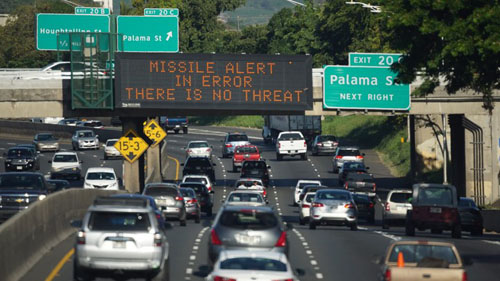Download PDF
RCA TRAINING
Root Cause Analysis training by Sologic provides the tools, skills, and knowledge necessary to solve complex problems in any sector, within any discipline, and of any scale. Learn MoreSOFTWARE
Sologic’s Causelink has the right root cause analysis software product for you and your organization. Single users may choose to install the software locally or utilize the cloud. Our flagship Enterprise-scale software is delivered On Premise or as SaaS in the cloud. Learn More On January 13, 2018 at 8:07AM a statewide alert was issued in Hawaii stating:
On January 13, 2018 at 8:07AM a statewide alert was issued in Hawaii stating:
“BALLISTIC MISSILE THREAT INBOUND TO HAWAII.
SEEK IMMEDIATE SHELTER.
THIS IS NOT A DRILL.”
People naturally experienced terror as they rushed to shelter or to be with their loved ones. It is a wonder no one was hurt or killed during the ensuing panic, which lasted 38 minutes. Of course, we all know the rest of the story at this point: The alert was a false alarm.
The Hawaii Emergency Management Agency is responsible for issuing alerts for disaster events, such as tsunamis, volcanos, earthquakes, and lately (due to tensions with North Korea) for nuclear attack. Drills for a potential nuclear attack had taken place at least twice since the Fall of 2017.
In this case, a night-shift supervisor decided to run a drill to test the incoming day-shift staff. He posed as a U.S. Pacific Command official and played a recorded message to the emergency workers which included the phrase “Exercise, exercise, exercise.” But it also included the phrase “This is not a drill.”
The day-shift supervisor was aware of the drill, but thought it was intended to test the night-shift workers and was therefore not prepared to actually play a supervisory role in the drill.
The day-shift Warning Officer heard most of the recording, but did not hear the “Exercise, exercise, exercise” part at the beginning of the warning. Therefore he thought the warning was real and proceeded to issue the statewide alert. The Warning Officer is able to do this on his/her own without input from anyone else.
The mistake was realized very quickly after the alert went out. However there an update was not issued for 38 minutes because there was no system in place to manage a false alarm. An approved message needed to be crafted and permission from FEMA had to be obtained prior to sending the update. An interim plan for the Governor of Hawaii to issue a correction via Twitter was delayed when he could not remember his password.
Solutions:
Hawaii authorities to require additional approvals before alerts and tests are transmitted.
The state suspended emergency alert drills after the false alarm and will provide more warning before drills.
Officials in Hawaii now require a second person to confirm sending out alerts.
The FCC issued new requirements to enhance the geo-targeting of cellphone alerts.
The FCC will require cellphone carriers to allow consumers to review any alert for up to 24 hours after they receive them.
Contact us to learn more about RCA training and software.
NOTE: Sologic did not investigate this incident and does not attest to the accuracy of the included RCA. The RCA was assembled with publicly available information and is intended to illustrate how this event could look in Sologic’s RCA format. The above Solutions were those actually put in place for this incident by the various government officials.